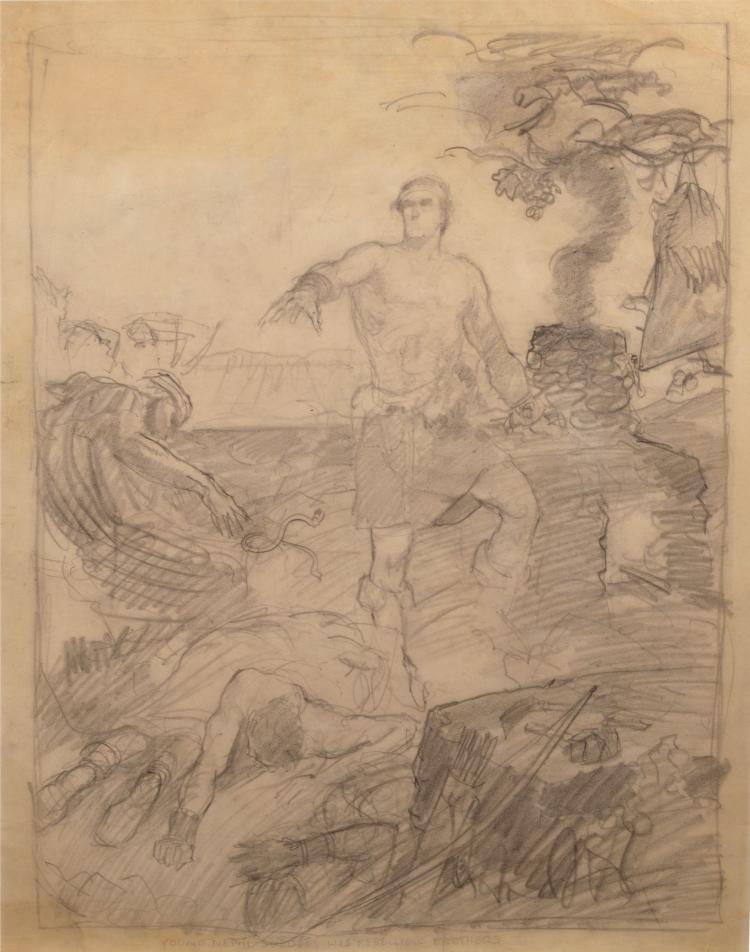You are here
Study of "Nephi Subdues His Rebellious Brothers"
| Title | Study of "Nephi Subdues His Rebellious Brothers" |
| Publication Type | Artwork |
| Year of Publication | Not Available |
| Authors | Friberg, Arnold |
| Keywords | Laman (Son of Lehi); Lemuel (Son of Lehi); Nephi (Son of Lehi); Sons of Ishmael |
| Abstract | Graphite on Paper 22 1⁄4 x 17 1⁄4 in. 1 Nephi 17: 53-55 This study for Nephi Subdues His Rebellious Brothers is a masterclass in composition and evidence of Friberg’s genius for perfecting an image until the final work. Standing near the center and on the highest ground is Nephi. To his left is a pair of tongs, for use in the kiln Nephi built in order to make tools and materials to build the ship that would carry his large family to the Promised Land. Having never built a ship, Nephi is following the instructions he receives through regular communion with God (1 Nephi 17). In the foreground are more tools—the kind found in a blacksmith’s working area. There is also the wood bow that Nephi made when his family was in dire need for food. By including the bow in this scene, Friberg not only reminds the viewer of Nephi’s story, but adeptly draws a comparison between Nephi making a bow—something he had never done before—for the survival of his family and the much larger project of building a boat without experience. To Nephi’s right are at least four figures, including Laman, Lemuel, and two sons of Ishmael. In the scripture account, Laman and Lemuel first mocked Nephi for his plans to build a boat (1 Nephi 17:18), then they complain about his work (1 Nephi 17:19), and, after explaining that building a ship requires the same faith that their forefather (e.g., Moses) had, his brothers become violent “and were desirous to throw me into the depths of the sea.” In this work, unlike in the final painting, we see that the figure immediately to Nephi’s right drops a cord. Though not explicitly stated in this instance, Nephi’s brothers and brothers-in-law (i.e., the sons of Ishmael) had bound Nephi on two other occasions: first, as they all travelled into the wilderness with their wives (1 Nephi 7:16); and, second, after having been at sea for several days without sighting land (1 Nephi 18:11). After having been “confounded” by Nephi’s words, Laman, Lemuel, and the sons of Ishmael “durst not lay their hands” on Nephi, “lest they should wither . . . so powerful was the Spirit of God; and thus it had wrought upon them” (1 Nephi 17:52). It was not until several days later that the Lord said, “Stretch forth thy hand . . . and they shall not wither before thee, but I will shock them” (1 Nephi 17:53). Here, Friberg has compressed several elements of the story into one scene, while remaining true to the overall narrative. In the oil painting, Friberg subtly simplifies the scene, removing two of the sons of Ishmael and making the remaining figures fill more of the canvas. He also increases the chiaroscuro affects, creating greater contrasts between lights and darks. Yet, side by side, this and the final work retain a remarkable power that, for members of The Church of Jesus Christ of Latter-day Saints, is among the most memorable and familiar works of art anywhere in the world. |
Terms of Use
Items in the BMC Archive are made publicly available for non-commercial, private use. Inclusion within the BMC Archive does not imply endorsement. Items do not represent the official views of The Church of Jesus Christ of Latter-day Saints or of Book of Mormon Central.
Bibliographic Citation
Scripture Reference
Subscribe
Get the latest updates on Book of Mormon topics and research for free

